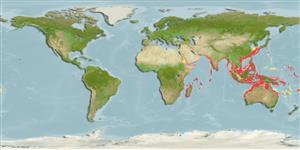>
Eupercaria/misc (Various families in series Eupercaria) >
Sciaenidae (Drums or croakers)
Etymology: Atrobucca: Latin, atro = black + Latin, bucca = mouth (Ref. 45335).
More on authors: Jordan & Thompson.
Environment: milieu / climate zone / depth range / distribution range
Ecologia
marinhas demersal; intervalo de profundidade 45 - 200 m (Ref. 9772), usually ? - 120 m (Ref. 7483). Deep-water; 38°N - 31°S, 30°E - 137°E
Indo-West Pacific: Mozambique and Natal, South Africa (Ref. 12484), India (Ref. 4373); China, Japan, Philippines, Indonesia, and off northern Australia.
Length at first maturity / Tamanho / Peso / Idade
Maturity: Lm 14.5 range ? - ? cm
Max length : 45.0 cm SL macho/indeterminado; (Ref. 9772); common length : 25.0 cm SL macho/indeterminado; (Ref. 9772)
Espinhos dorsais (total) : 10 - 11; Raios dorsais moles (total) : 27 - 33; Espinhos anais: 2; Raios anais moles: 7. A small, moderately-deep-bodied species. Swim bladder carrot-shaped, with 24 to 30 pairs of branched appendages, each with a dorsal and a ventral limb, regularly arranged so that the twiglets of the dorsal limb point backwards, and those near the tip of the ventral limb point forwards. The lateral line scales reaching the tip of the caudal fin. The linings of the mouth, gill chamber and body cavity black.
Found in coastal waters down to a depth of 200 m or deeper (Ref. 9772), on seaweed beds and gravel (Ref. 11230). Important food fish.
Life cycle and mating behavior
Maturidade | Reprodução | Desova | Ovos | Fecundidade | Larvas
Sasaki, K. and P.J. Kailola, 1988. Three new Indo-Australian species of the sciaenid genus Atrobucca, with a reevaluation of generic limit. Jap. J. Ichthyol. 35(3):261-277. (Ref. 7483)
Categoria na Lista Vermelha da IUCN (Ref. 130435: Version 2024-1)
Ameaça para o homem
Harmless
Utilização humana
Pescarias: espécies comerciais
Ferramentas
Relatórios especiais
Descarregue XML
Fontes da internet
Estimates based on models
Preferred temperature (Ref.
123201): 18.2 - 27.9, mean 24.5 °C (based on 609 cells).
Phylogenetic diversity index (Ref.
82804): PD
50 = 0.5010 [Uniqueness, from 0.5 = low to 2.0 = high].
Bayesian length-weight: a=0.00832 (0.00527 - 0.01312), b=3.03 (2.90 - 3.16), in cm total length, based on LWR estimates for this species & (Sub)family-body (Ref.
93245).
Nível Trófico (Ref.
69278): 4.0 ±0.69 se; based on food items.
Generation time: 4.8 (3.1 - 7.6) years. Estimated as median ln(3)/K based on 11
growth studies.
Resiliência (Ref.
120179): Médio, tempo mínimo de duplicação da população 1,4 - 4,4 anos (K=0.15-0.3).
Fishing Vulnerability (Ref.
59153): High vulnerability (56 of 100).
Climate Vulnerability (Ref.
125649): High to very high vulnerability (69 of 100).
Nutrients (Ref.
124155): Calcium = 25.4 [14.4, 58.5] mg/100g; Iron = 0.379 [0.177, 0.825] mg/100g; Protein = 18.5 [17.3, 19.7] %; Omega3 = 0.343 [0.154, 0.625] g/100g; Selenium = 13 [6, 30] μg/100g; VitaminA = 14.3 [2.9, 74.6] μg/100g; Zinc = 0.413 [0.281, 0.626] mg/100g (wet weight);
